Kaiser Health Tracking Poll: April 2016
Politics
The April Kaiser Health Tracking Poll examines the role of health care issues in the presidential election.
KEY FINDINGS:
- Health care is one of the top four issues mentioned by voters when asked which issues they most want to hear candidates discuss in the campaign, but half as many cite health care as mention the economy and jobs.
- When asked specifically what health care issues voters would most like to hear the presidential candidates discuss, the 2010 health care law (ACA) and health care costs top the list.
- Overall ratings of the ACA lean negative this month, with 38 percent saying they have a favorable view and 49 percent saying they have an unfavorable view.
- The percentage of Democrats who have an unfavorable opinion of the law increased 6 percentage points from last month. Of the Democrats who did not express a favorable opinion, 40 percent want to expand what the law does.
Election Watch: The Role of Health Care Issues in Politics
Economy Tops Issues that Public Wants Presidential Candidates to Talk About, Health Care Ranks Fourth
With news about the 2016 Presidential election topping national news, the April Tracking survey asks which issues- in their own words- American voters most want to hear candidates discuss in the campaign. Health care is one of the top four issues mentioned by voters, but half as many cite health care as mention the economy and jobs. Nearly one-third of registered voters (30 percent), regardless of party, would like candidates to focus on the economy and jobs. This is followed by national security (21 percent) and immigration (17 percent). Health care (15 percent) ranks fourth for voters this election cycle, compared to 2012 when it ranked second behind the economy and jobs. Social issues such as race relations and same-sex marriage (10 percent), education (8 percent), and foreign policy (8 percent) are mentioned by about one in ten Americans.
Larger shares of Democratic voters mention health care (19 percent) than Republican voters (12 percent), while Republican voters are more likely than Democratic voters to mention national security (28 percent and 14 percent, respectively) or immigration (25 percent and 10 percent, respectively).
| Table 1: Top Issues American Voters Want Presidential Candidates to Discuss | ||||
| Thinking about the campaign for the presidential election in November, what two issues would you most like to hear the presidential candidates talk about?(open-end) | All Registered Voters | RepublicanVoters | DemocraticVoters | IndependentVoters |
| Economy and Jobs | 30% | 35% | 27% | 32% |
| National Security | 21 | 28 | 14 | 20 |
| Immigration and Border Control | 17 | 25 | 10 | 17 |
| Health Care | 15 | 12 | 19 | 14 |
| Social Issues | 10 | 7 | 16 | 5 |
| Foreign Policy | 8 | 9 | 6 | 9 |
| Education | 8 | 3 | 13 | 10 |
| NOTE: Only top seven responses listed. Percentages may add up to more than 100% due to multiple responses. | ||||
ACA and Health Care Costs Are Top Health Care Issues
When asked specifically what health care issues voters would most like to hear the presidential candidates discuss, the 2010 health care law (the Affordable Care Act, or ACA) and health care costs top the list with more than one-third of registered voters mentioning each. This is followed by expanding health care coverage for the uninsured (26 percent) and Medicare (10 percent).
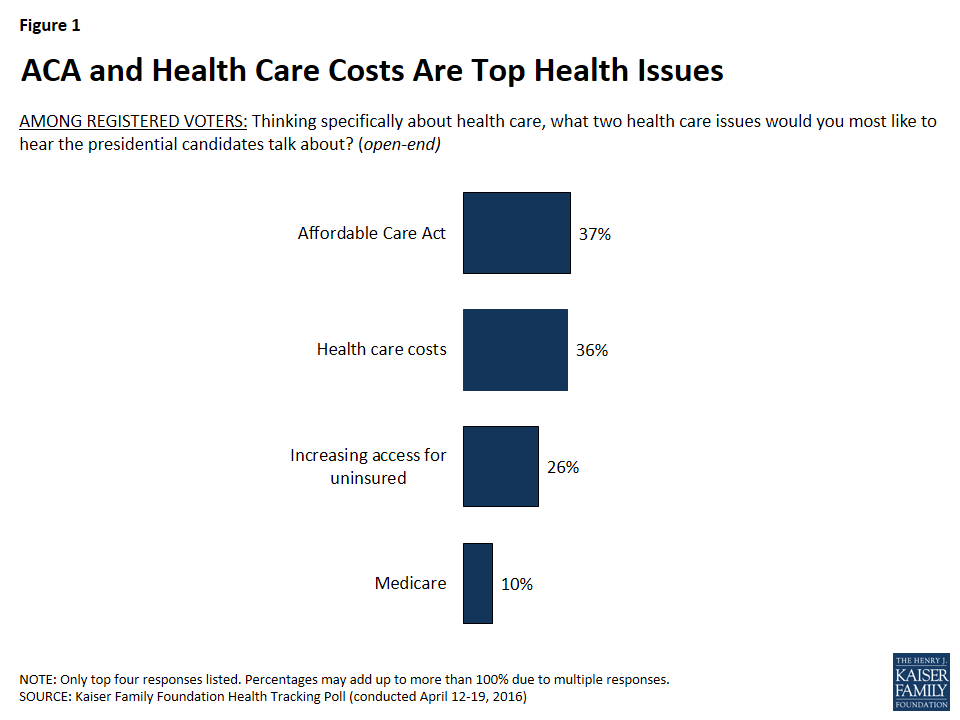
Nearly half of Republican voters (45 percent) mention the ACA as the health care issue they want to hear candidates discuss, including 28 percent explicitly mention repealing or opposing it. Slightly more Democratic voters mention expanding coverage for the uninsured (39 percent) and health care costs (37 percent) than the ACA (30 percent), and equal shares of independent voters mention the ACA and health care costs (37 percent each).
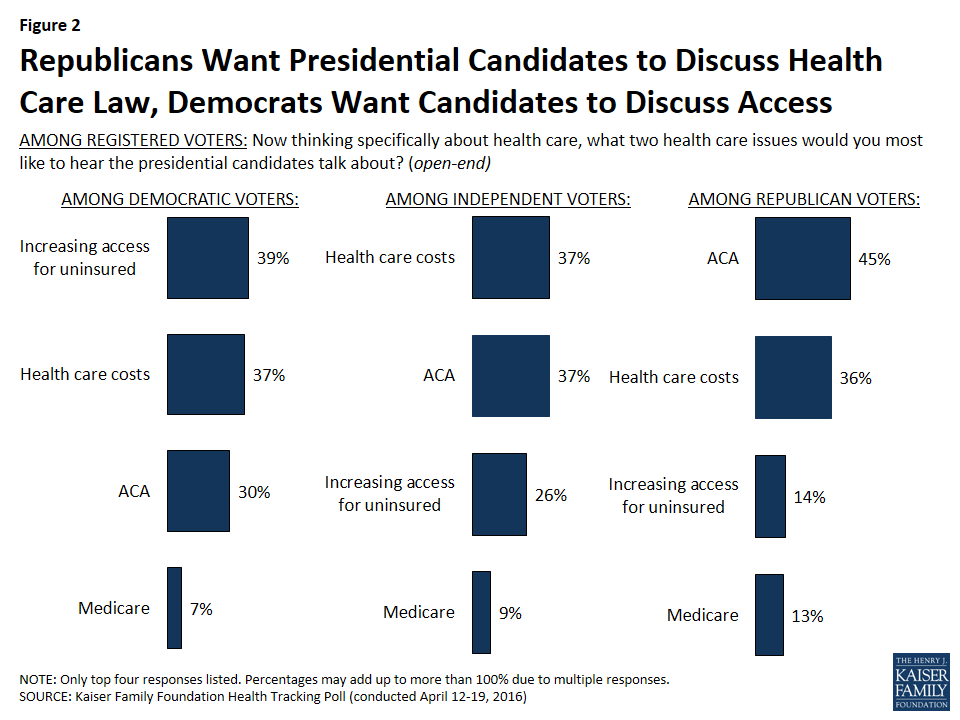
Americans’ Opinions of the Affordable Care Act
The public remains split on what they want Congress to do with the health care law moving forward with 32 percent supporting repeal of the law and a similar share (30 percent) supporting expanding the law; 14 percent would like to see it implemented as is and 11 percent support scaling back the law.
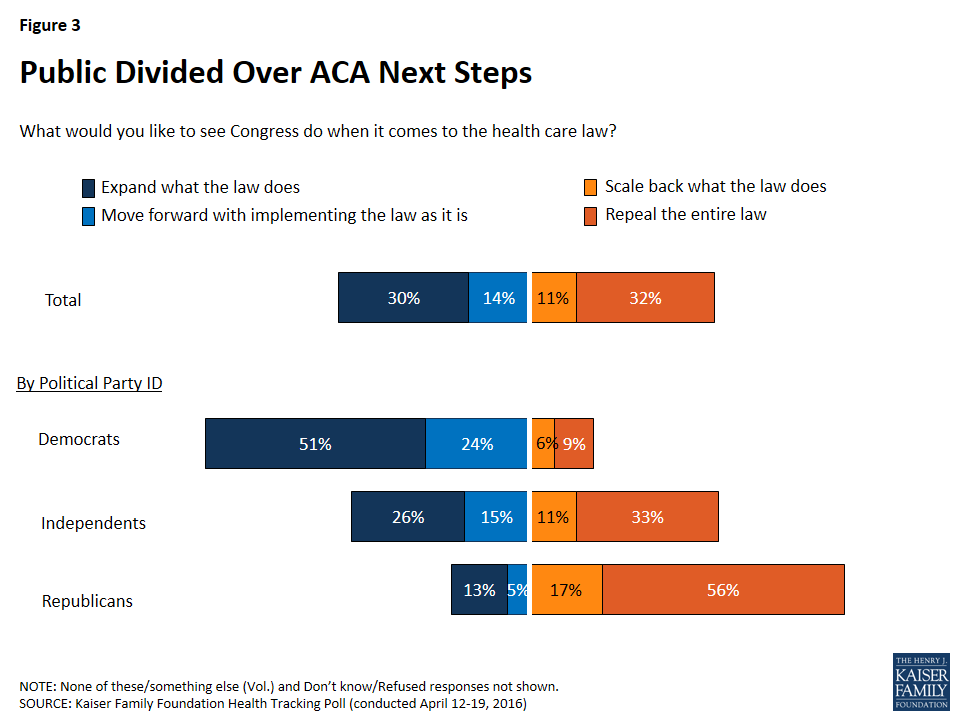
About one-third (32 percent) would like to see Congress repeal the health care law, yet the public is divided on whether Congress should repeal the law and replace it with a Republican-sponsored alternative or repeal and not replace it (12 percent, each).
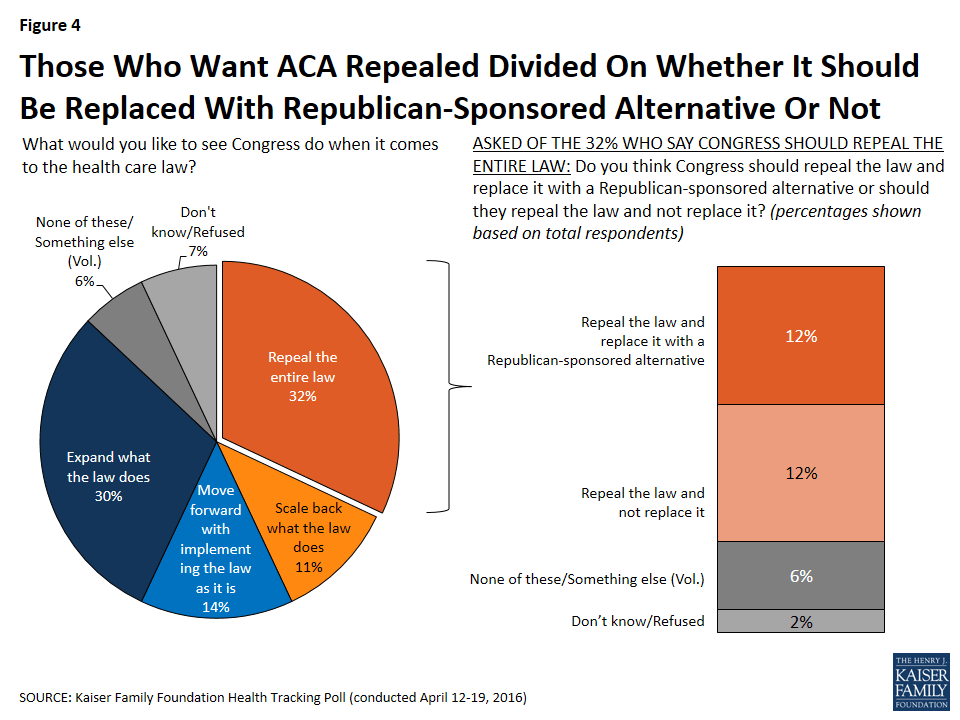
About half of Democrats (51 percent) want Congress to expand what the law does. This is a significant increase from 36 percent in December 2015, and continues an upward trend first noticed in January 2016. This increase may be due to the rhetoric surrounding universal health care in the Democratic presidential campaign, with both candidates advocating universal coverage as a goal.
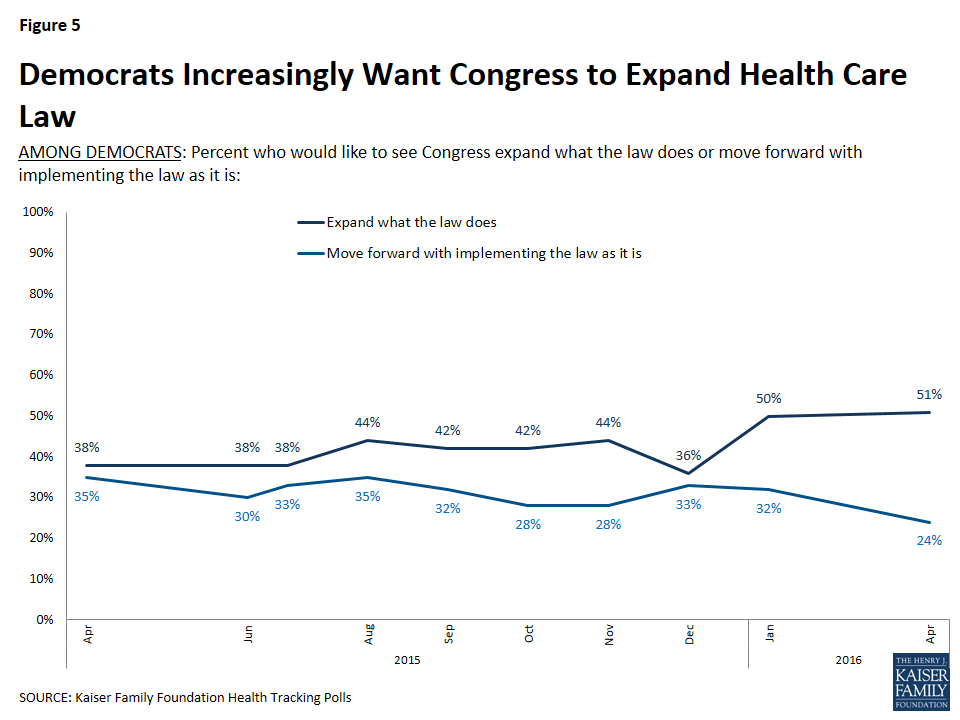
Overall ratings of the ACA lean negative this month, with 38 percent saying they have a favorable view and 49 percent saying they have an unfavorable view.
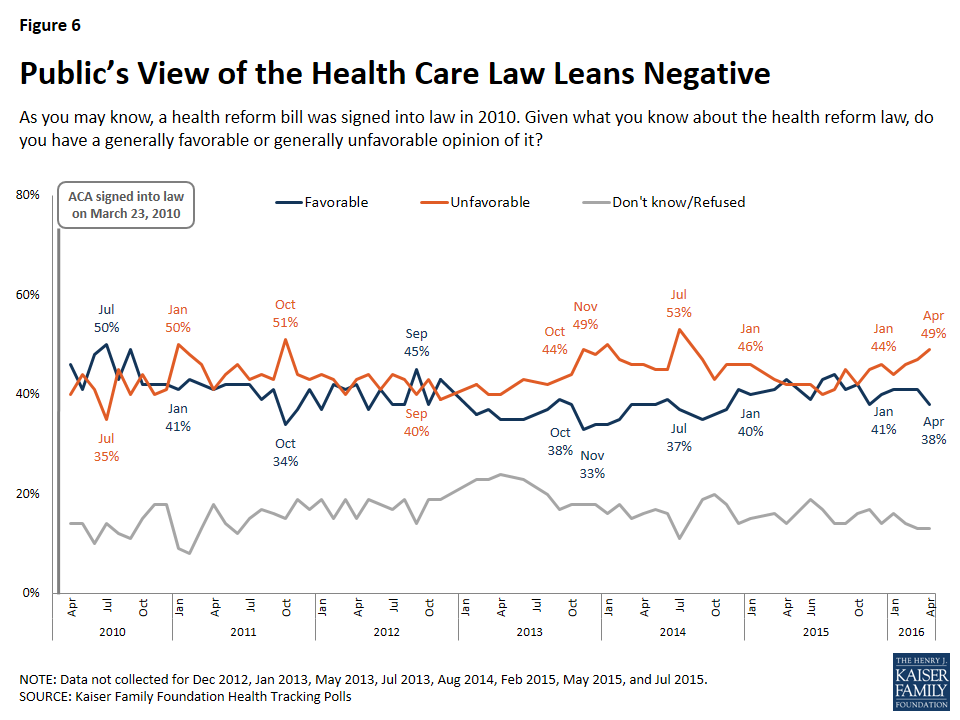
The percentage of Democrats who have an unfavorable opinion of the law increased 6 percentage points to 25 percent, up from 19 percent last month. Of the Democrats who did not express a favorable opinion of the ACA, 40 percent want to expand what the law does, 20 percent do not know what they would like to see Congress do when it comes to the health care or mention something else, 19 percent want to repeal the entire law, 13 percent want to move forward with implementing the law as it is, and 9 percent want to scale back what the law does.
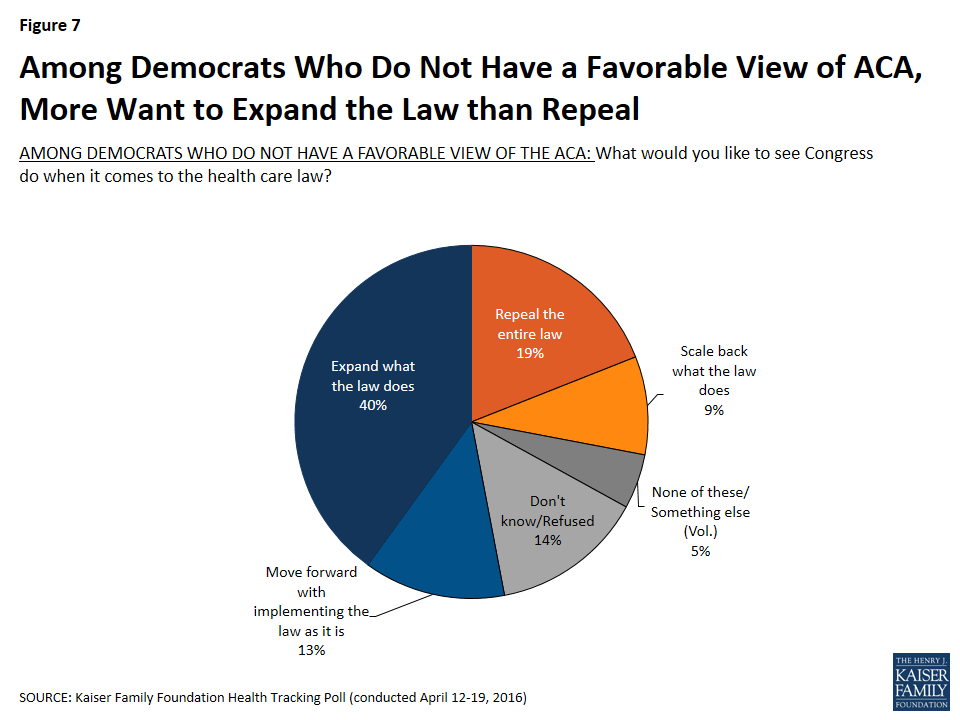
Water Safety
The April Kaiser Health Tracking Poll continues Kaiser Family Foundation tracking of perceptions of the safety of drinking water.
KEY FINDINGS:
- The majority of individuals living in the Midwest rate the job being done by their state to ensure the safety of the public drinking water as fair or poor.
- Women are less confident in government’s ability to ensure the safety of public services, including the public sewer system, the electricity system, and the water supply, than their male counterparts.
- The American public negatively rates the job being done by the federal government in protecting the safety of public drinking water and is more positive than negative on the job being done by their individual states.
- The terrorist attacks in Brussels and other conflicts involving ISIS and the 2016 presidential campaign are the top two stories capturing the attention of the American public this month.
- Americans are increasingly paying attention to news about the unsafe lead levels in Flint, Michigan’s water and the Zika virus outbreak.
Government’s Ability to Safeguard Public Services
With news that several government officials are facing charges in connection with the contamination of Flint, Michigan’s water supply1 , the April Tracking Poll examines Americans’ confidence in the government’s ability to ensure the safety of public services, including public water supplies.
Protecting the Safety of Public Drinking Water
While a majority of the American public positively rate the job being done by the state government in protecting the safety of public drinking water, attitudes are more negative in their evaluations of the job being done by the federal government.
Over half of the public say their state is doing an “excellent” (17 percent) or “good” (37 percent) job in protecting the safety of public drinking water. About three in ten (31 percent) rate the job being done by their state as “fair,” and 14 percent rate it as “poor.”
Only seven percent of Americans rate the job being done by the federal government in protecting the safety of public drinking water as “excellent,” 29 percent rating it “good,” 36 percent rating it “fair,” and one-fourth (26 percent) rating it as “poor.” There are no partisan differences in evaluations of the job currently being done by state governments or the federal government with Republicans and Democrats being equally negative in their evaluation of the federal government and more divided on the job being done by their state.
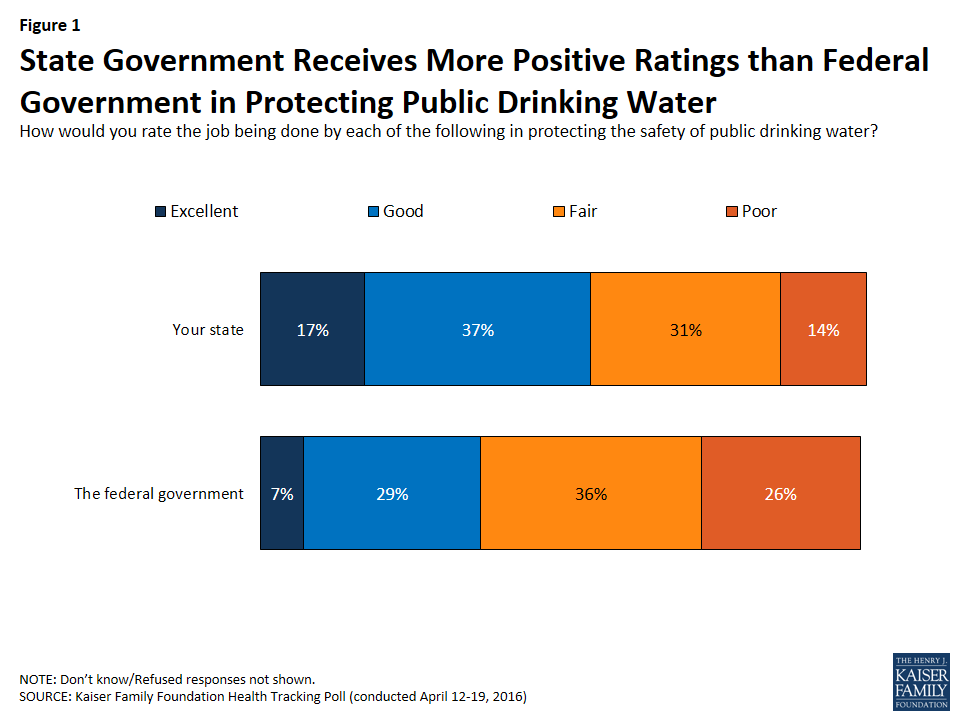
Individuals living in the Midwest, where Flint, Michigan is located, are less positive in their evaluations of their state’s job of protecting the safety of the public drinking water. When controlling for demographic factors (age, income, education level, party identification, gender, and race/ethnicity), results indicate that individuals living in the Midwest are negative in their evaluations with slightly more than half (52 percent) giving their state a rating of “fair” or “poor,” which is similar to those living in the Northeast (49 percent), but slightly more negative than those living in the South (43 percent), and significantly more negative than those living in the West (39 percent).
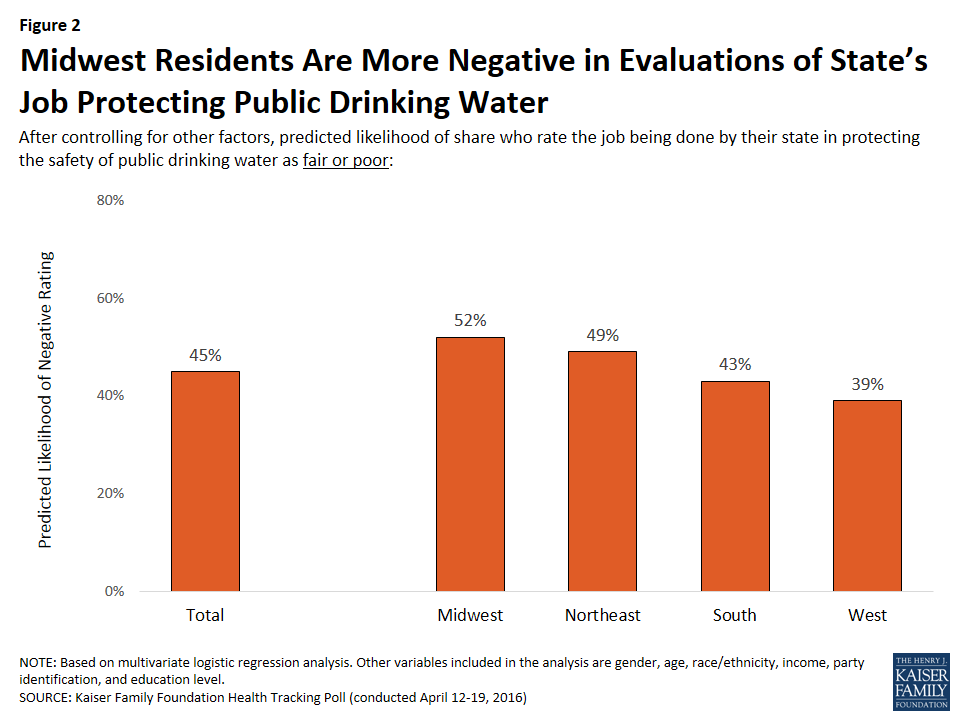
Confidence in State Government’s Ability to Ensure Safety of Public Services in the Future
While the public is more divided on evaluations of their state’s current job protecting public drinking water, the majority of Americans are not very confident that their state government can ensure the safety of their electricity system, the public sewer system, or the public water supply over the next five years.
Seven in ten Americans say they are not very confident in the state government’s ability to ensure the safety of the water while 29 percent say they are very or extremely confident. The results are similar to opinions about the state’s ability to ensure the safety of the public sewer system (67 percent are not very confident while 31 percent are very or extremely confident), and to a lesser degree, the electricity system (59 percent are not very confident while 39 percent are very or extremely confident).
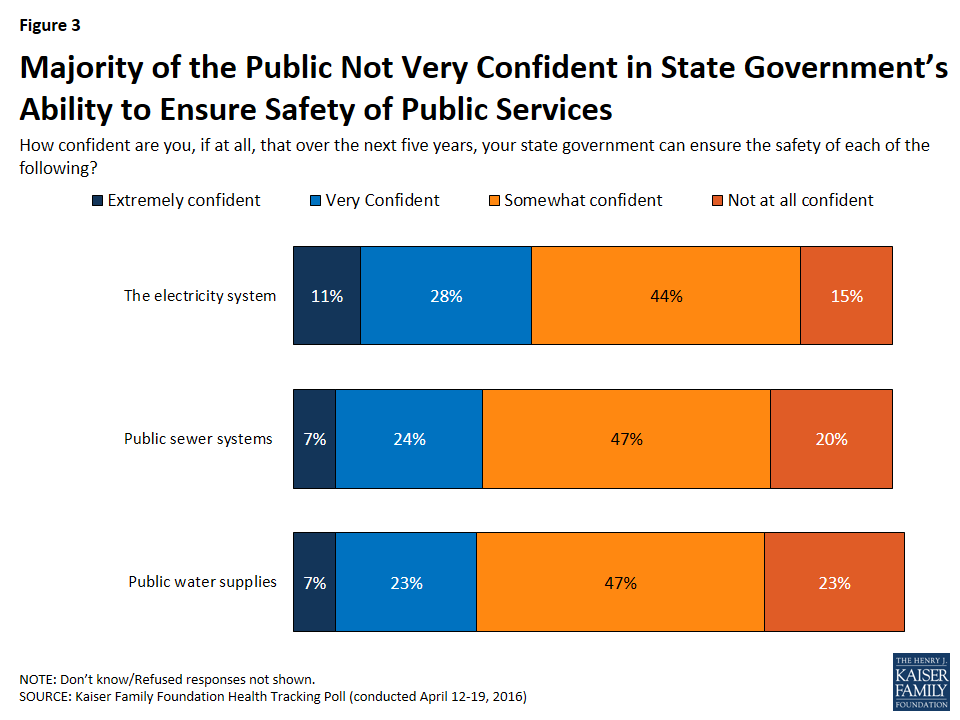
Overall, women are less confident in government’s ability to ensure the safety of public services than their male counterparts. Three-fourths of women (74 percent) are not very confident in their state’s ability to ensure the safety of their water, compared to 66 percent of men. These gender differences are also apparent when asked about ensuring the safety of the public sewer system (71 percent of women are not very confident, compared to 62 percent of men), and the electricity system (64 percent of women are not very confident, compared to 55 percent of men). These findings are consistent with other indicators suggesting that women care more about health-related issues than men.
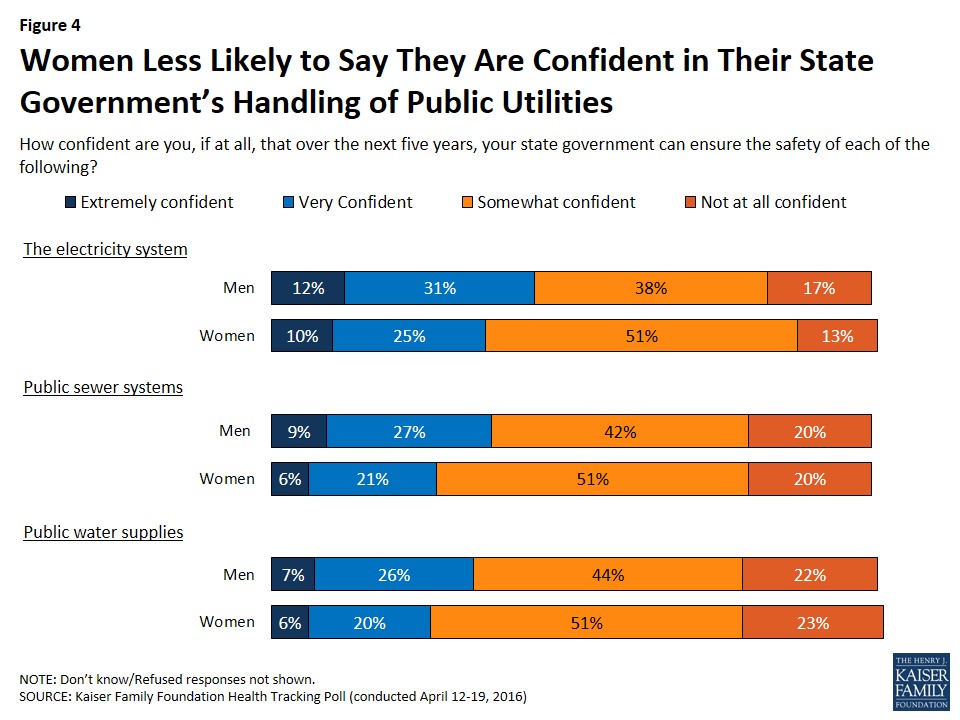
Kaiser Health Policy News Index: April 2016
The April Kaiser Health Tracking Poll finds that the top two stories capturing the attention of the American public are the terrorist attacks in Brussels and other conflicts involving ISIS and the 2016 presidential campaign, with 80 percent and 77 percent of Americans saying they are closely following these stories, respectively. Americans are increasingly paying attention to news about the unsafe lead levels in Flint, Michigan’s water (70 percent) and the Zika virus outbreak (61 percent), up from 63 percent and 54 percent respectively in March 2016. A majority of Americans (66 percent) also report closely following news about the FBI order requiring Apple to unlock the San Bernardino shooting suspect’s iPhone. Fewer Americans report closely following news about the Supreme Court case regarding access to contraception under the ACA (48 percent) and President Obama’s proposal to increase government funding for treatment and prevention of heroin and prescription painkiller addiction (34 percent).
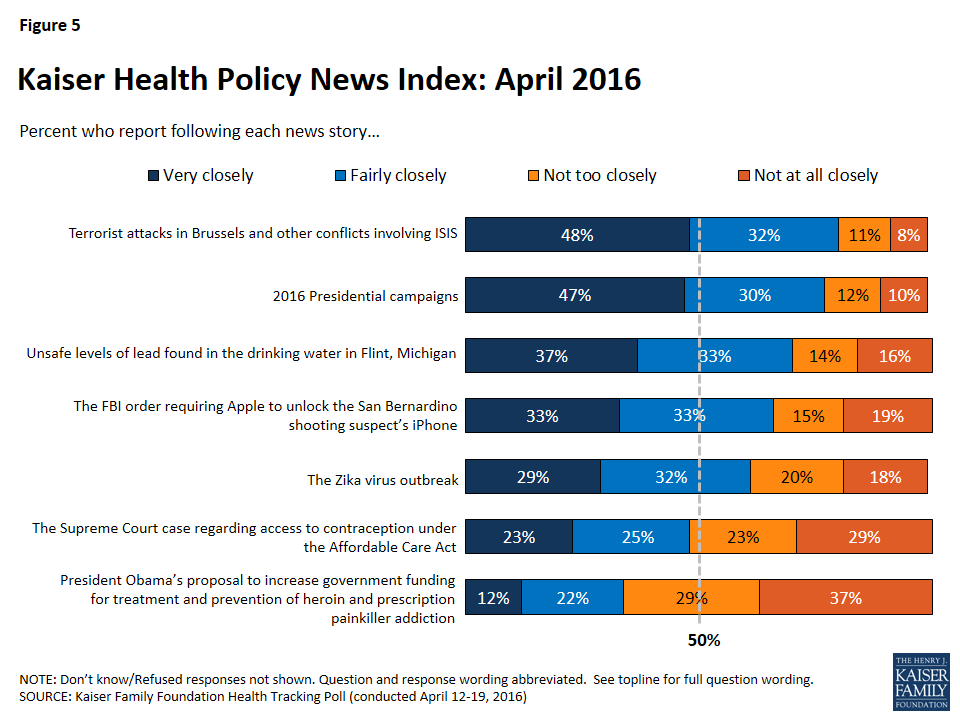
Substance Abuse And Mental Health
The April Kaiser Health Tracking Poll examines public opinion on the severity of health problems in the U.S. and takes a closer look at attitudes towards current health problems; including access to substance abuse treatment and mental health services.
KEY FINDINGS:
- Cancer tops the public’s list of extremely serious health problems in the U.S., followed by contaminated drinking water, heroin abuse, two topics that have garnered media attention recently.
- Although heroin technically falls into the same opioid family as prescription painkillers, Americans perceptions of the seriousness of addiction to these two drugs as well as the discrimination faced by those who use them are different.
- Forty-four percent say they personally know someone who has been addicted to prescription painkillers; a majority of Americans say that lack of access to care for people with substance abuse issues is a problem.
- A quarter report that a doctor or health professional has told them or another family member living in their household that they have a serious mental health condition; 21 percent report that there has been a time when they or another family member thought they might need mental health services but did not get them.
- Many Americans are unaware of the legal requirement that insurance plans must have the same rules for mental health benefits and substance abuse treatment as other medical services.
Serious Health Problems in the U.S.
When given a list of health issues facing the country, cancer tops the list, with 43 percent saying it is an extremely serious problem. In the midst of news stories about the contamination of the water in Flint, Michigan, just over one-third (35 percent) rate contaminated drinking water as an extremely serious problem. Similar shares name heroin abuse (35 percent), lack of access to mental health care (33 percent) and obesity (33 percent) as extremely serious problems. About three in ten say diabetes (31 percent), abuse of strong prescription painkillers, sometimes called opioids (28 percent), and heart disease (27 percent) are extremely serious problems, and about a quarter say the same for environmental contamination (26 percent) and lack of access to health care (25 percent). At the bottom of the public’s list are lack of access to affordable healthy food (21 percent) and alcohol abuse (19 percent).
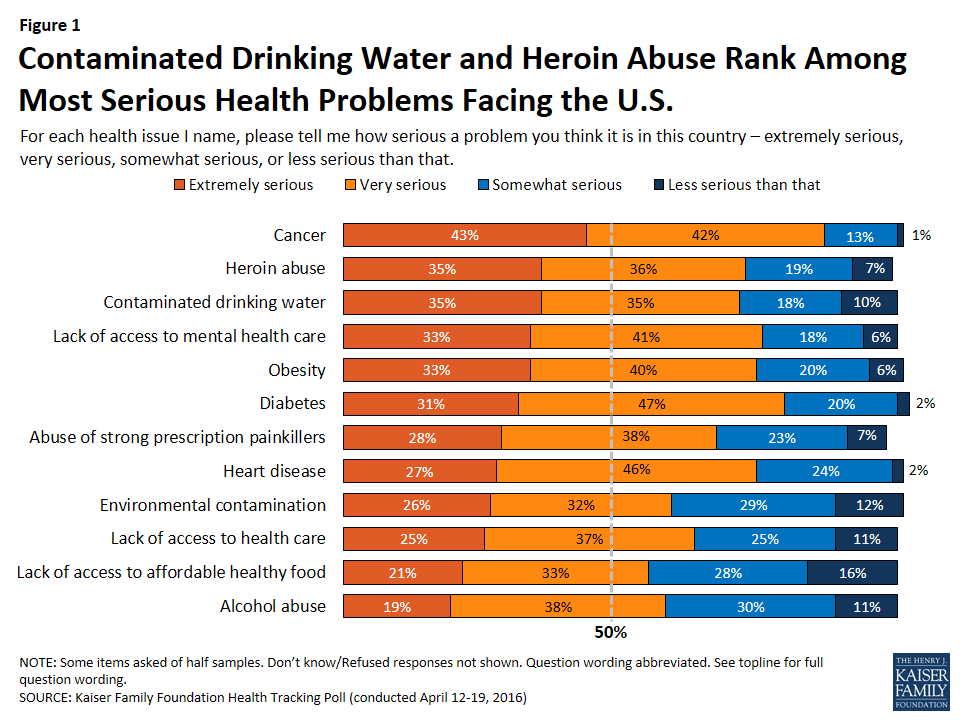
A Closer Look at Substance Abuse
More than one-third of Americans (35 percent) say heroin abuse is an extremely serious problem in the U.S., compared to 28 percent who say the same about abuse of strong prescription painkillers, and less than one in five (19 percent) who say alcohol abuse is an extremely serious problem.
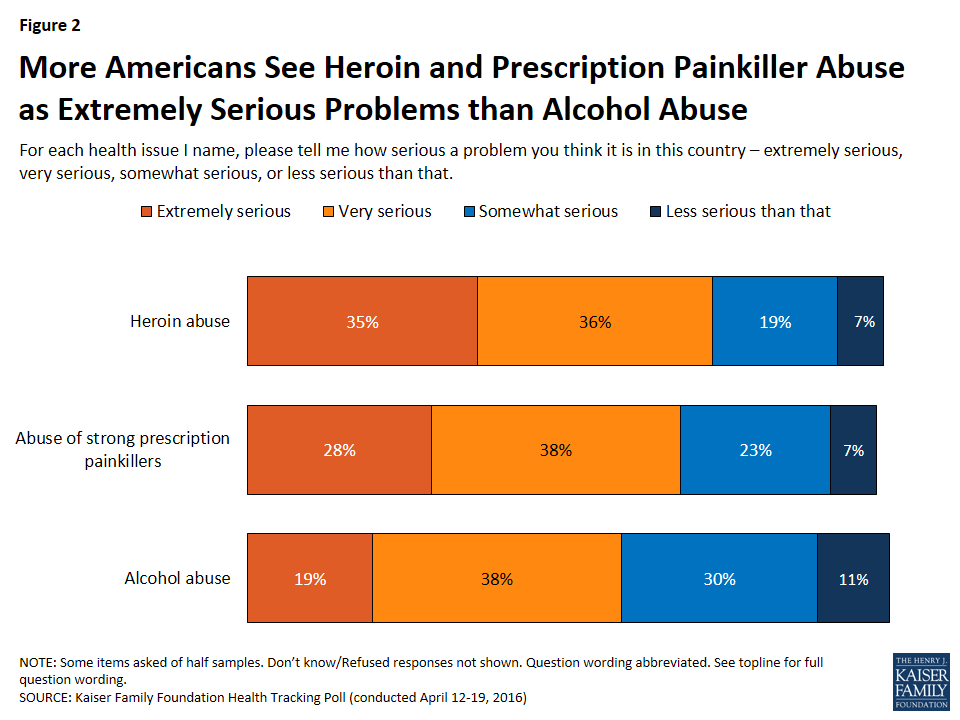
Personal Experience with Prescription Drug Addiction
Prescription drug addiction impacts nearly half of the public on a personal level. Forty-four percent say they personally know someone who has been addicted to prescription painkillers, with about a quarter (26 percent) saying the person they know is an acquaintance, 21 percent saying a close friend, 20 percent saying a family member, and 2 percent saying themselves.
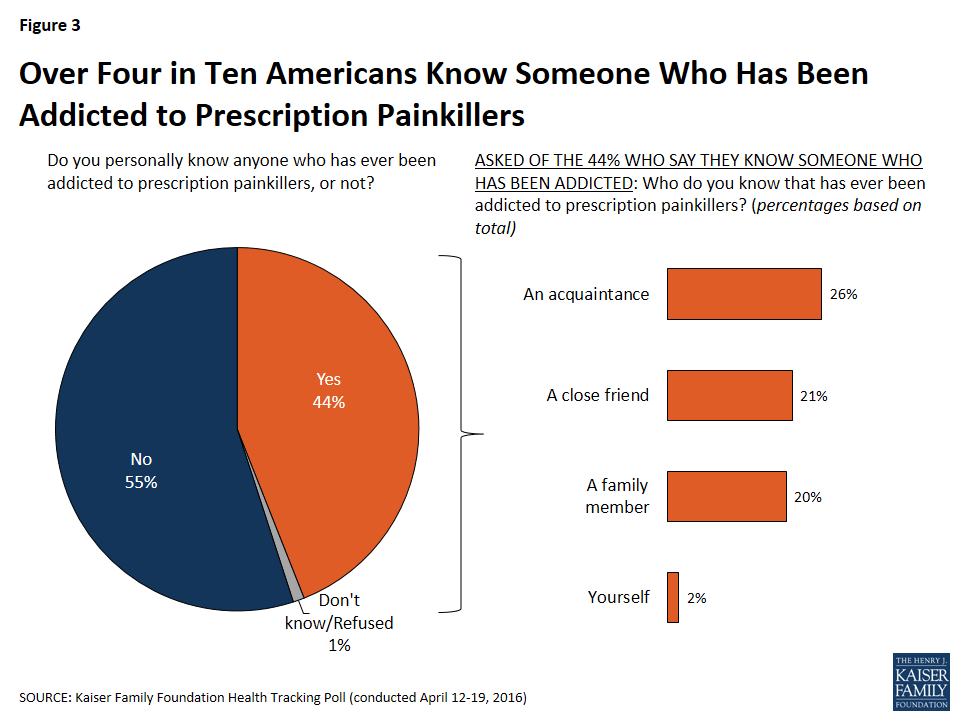
Access to Care
A majority of Americans say that lack of access to care for people with substance abuse issues is a problem (75 percent), including 58 percent who say it is a major problem.
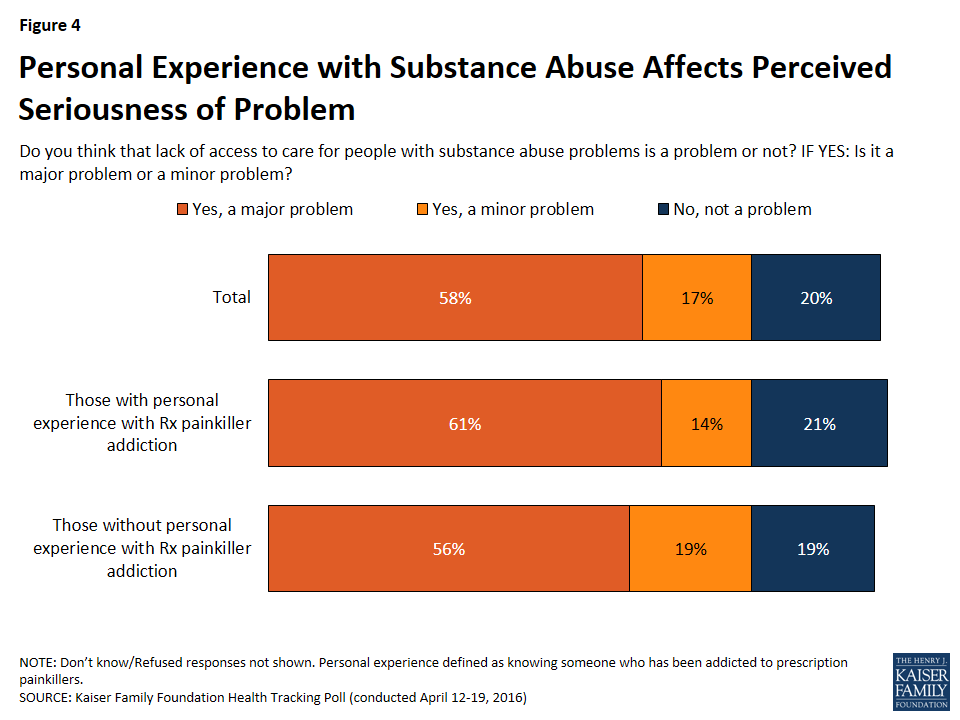
Perceptions of Heroin Abuse Compared to Prescription Painkiller Abuse
Although heroin technically falls into the same opioid family as prescription painkillers, the overall perception of the seriousness of addiction to these two drugs as well as the discrimination faced by those who use them is different. Just over one-third of the public (35 percent) say heroin abuse is an extremely serious problem, while 28 percent say opioid prescription painkiller abuse is. Additionally, about half of the public (52 percent) believe that people who are addicted to heroin face a lot of prejudice and discrimination in this country today, compared to just 38 percent who say people addicted to prescription painkillers do.
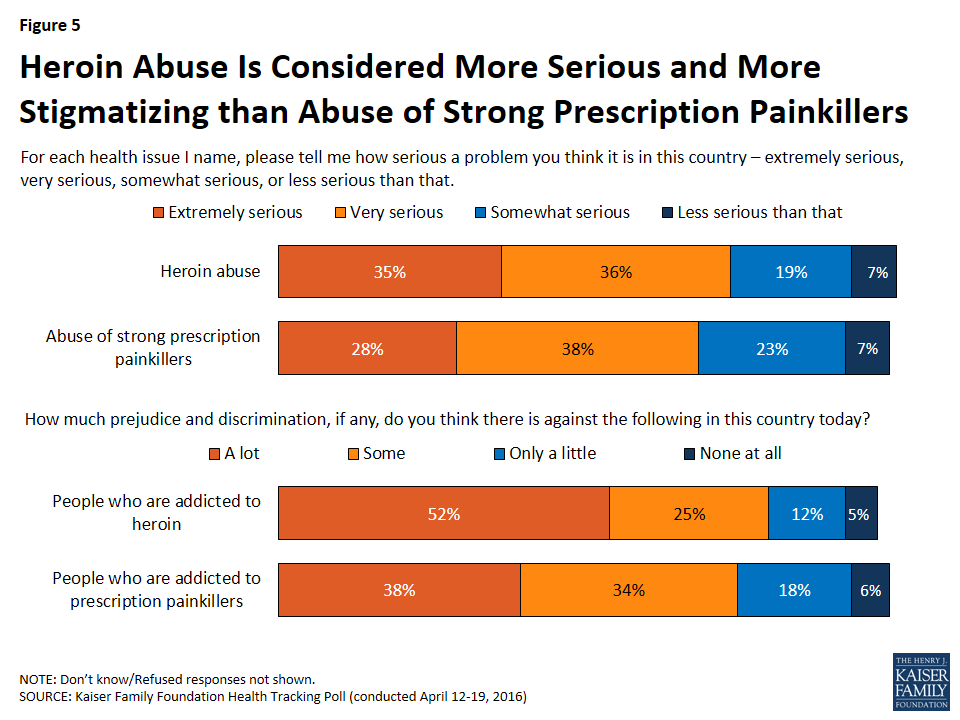
Actions to Fight The Increasing Rate of Prescription Painkiller Abuse
The subject of prescription painkiller abuse has gained attention from journalists and policy makers recently, most notably when President Obama announced $1.1 billion in additional funding along-side an array of new measures to fight the opioid addiction.2 Despite this, a majority of the public says the federal government is not doing enough to combat the recent increase in the number of people who are addicted to prescription painkillers (66 percent) or heroin (62 percent). Large shares say other groups aren’t doing enough to combat the problem, including their state governments (67 percent and 61 percent, respectively), doctors who prescribe prescription painkillers (63 percent and 56 percent), and particularly, individuals who use prescription painkillers or heroin (73 percent and 77 percent). Far fewer say police officers are not doing enough to combat painkiller abuse (37 percent) and heroin abuse (36 percent).
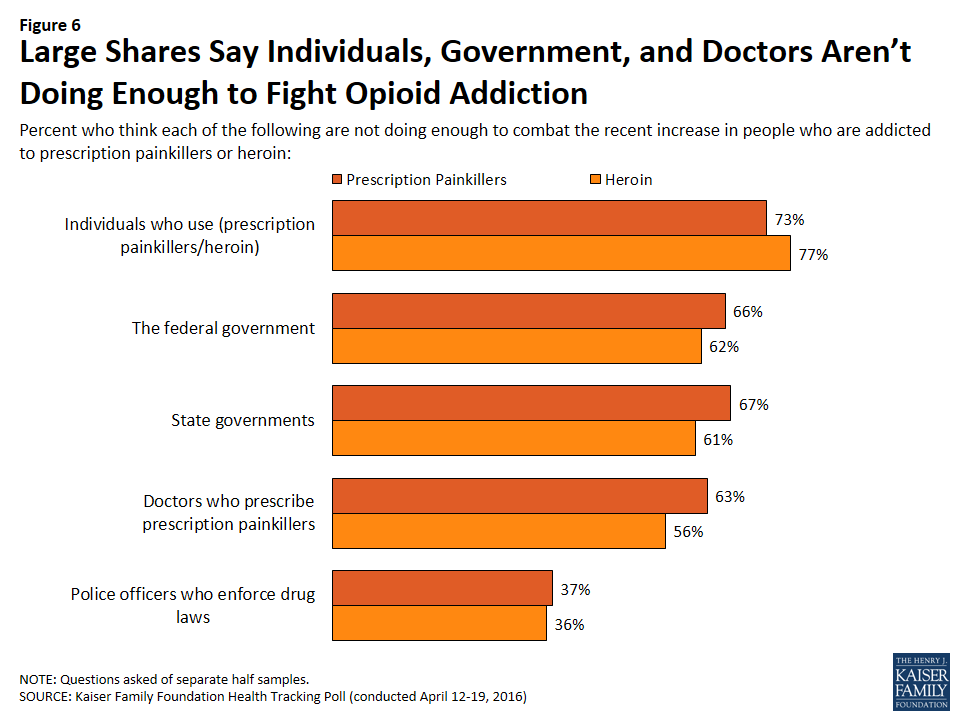
The poll also assesses the public’s views on expanding access to a drug called Narcan, or Naloxone, which can prevent people from dying if they are experiencing an overdose of a prescription painkiller or heroin. Currently, some states have made this drug available to adults without a prescription while others restrict the sale of this drug because they think it might encourage the use of illegal drugs. Nearly six in ten Americans (59 percent) think that these drugs should only be allowed with a prescription, while just more than a third (36 percent) think that it should be available without one. The share in favor of access without a prescription is significantly higher among individuals who report a personal experience with prescription painkiller abuse than those without (45 percent vs. 30 percent). Also, Democrats and independents are more likely to favor access without a prescription and Republicans are (40 percent and 41 percent vs. 30 percent).
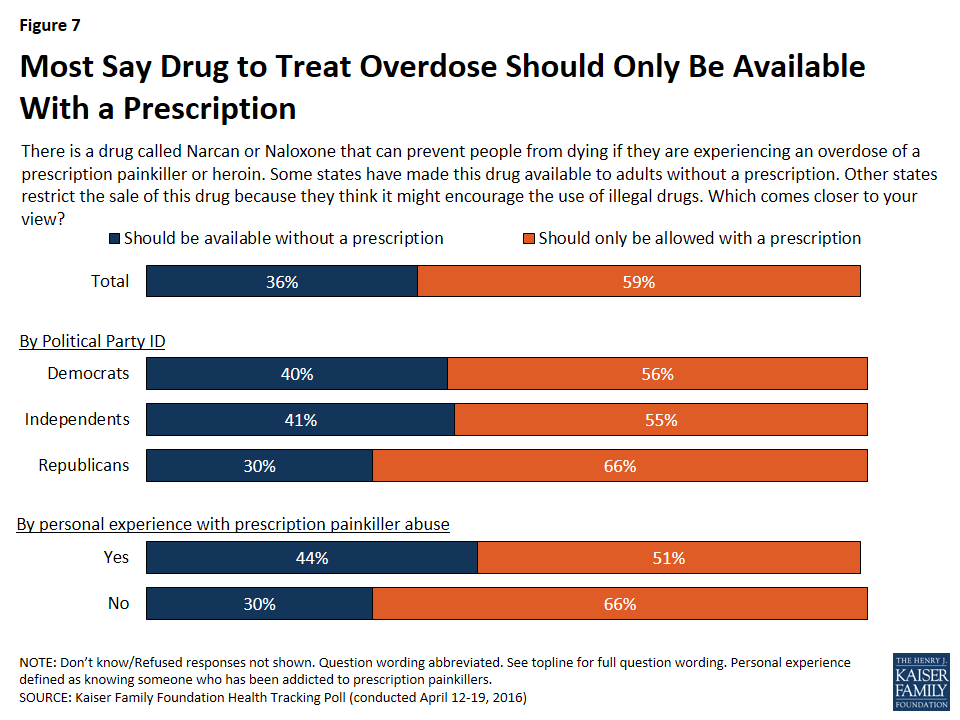
Policy Efforts to Curb Prescription Painkiller Abuse
The public thinks that a variety of policy efforts would be effective in reducing the abuse of prescription painkillers. Over eight in ten think that increasing pain management training for medical students and doctors (88 percent), increasing access to addiction treatment programs (86 percent), public education and awareness programs (84 percent), increasing research about pain and pain management (83 percent), and monitoring doctors’ prescription painkiller prescribing habits (82 percent) would be at least somewhat effective ways to reduce the number of people abusing prescription painkillers. Smaller shares think that encouraging people who are prescribed painkillers to dispose of any extras once they are no longer medically necessary (63 percent), reducing the social stigma around addiction (60 percent), and putting warning labels on prescription drug bottles that explain the risk of addiction (49 percent) would be at least somewhat effective.
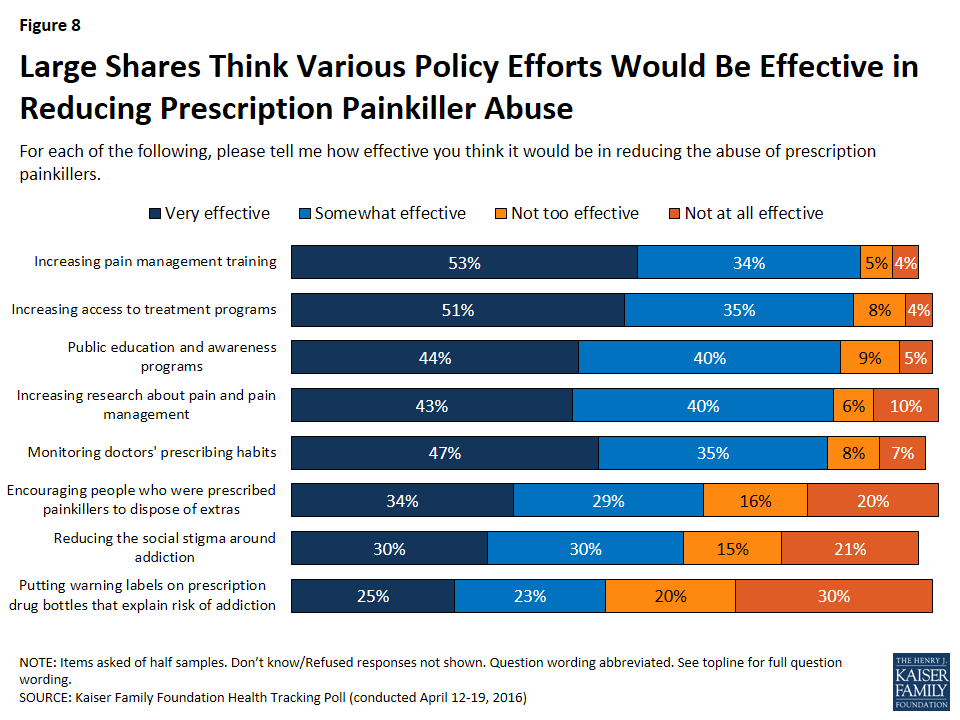
A Closer Look at Mental Health
Personal Impact of Mental Health
A quarter report that a doctor or health professional has told them or another family member living in their household that they have a serious mental health condition, such as depression or anxiety. Furthermore, about two in ten (21 percent) report that there has been a time when they or another family member thought they might need mental health services but did not get them. Individuals say they didn’t get mental health care because they couldn’t afford the cost (13 percent), insurance wouldn’t cover it (12 percent), there were afraid or embarrassed to seek care (10 percent), or they didn’t know where to go to get care (8 percent).
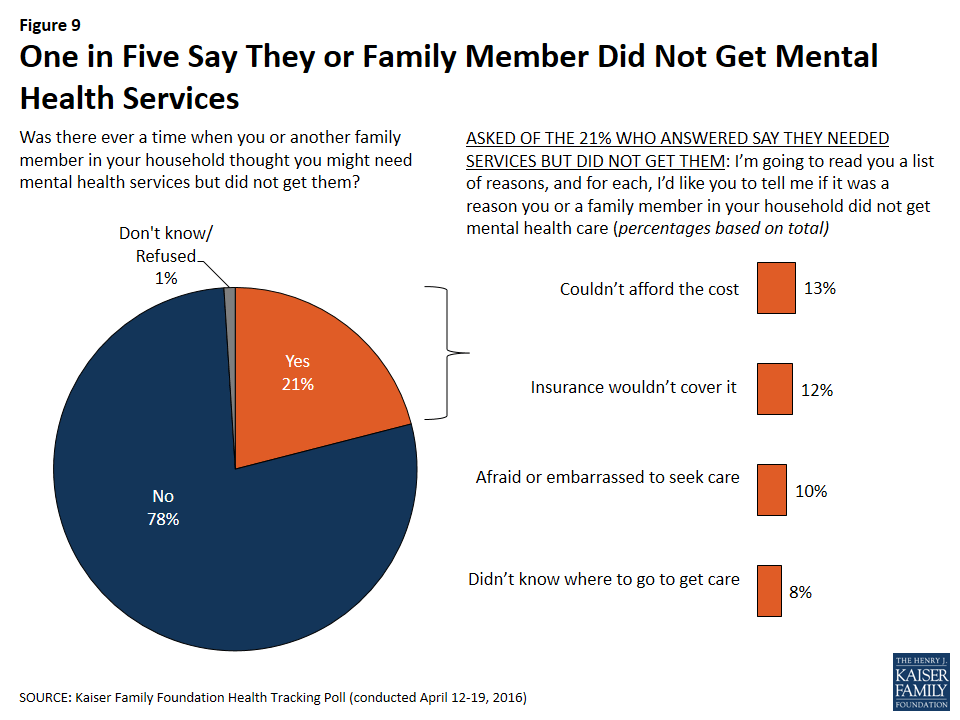
Perceptions About Access to Care for Those with Mental Health Conditions
Nearly nine in ten (87 percent) think that lack of access to care for people with mental health conditions is a problem, including 73 percent who say it is a major problem.
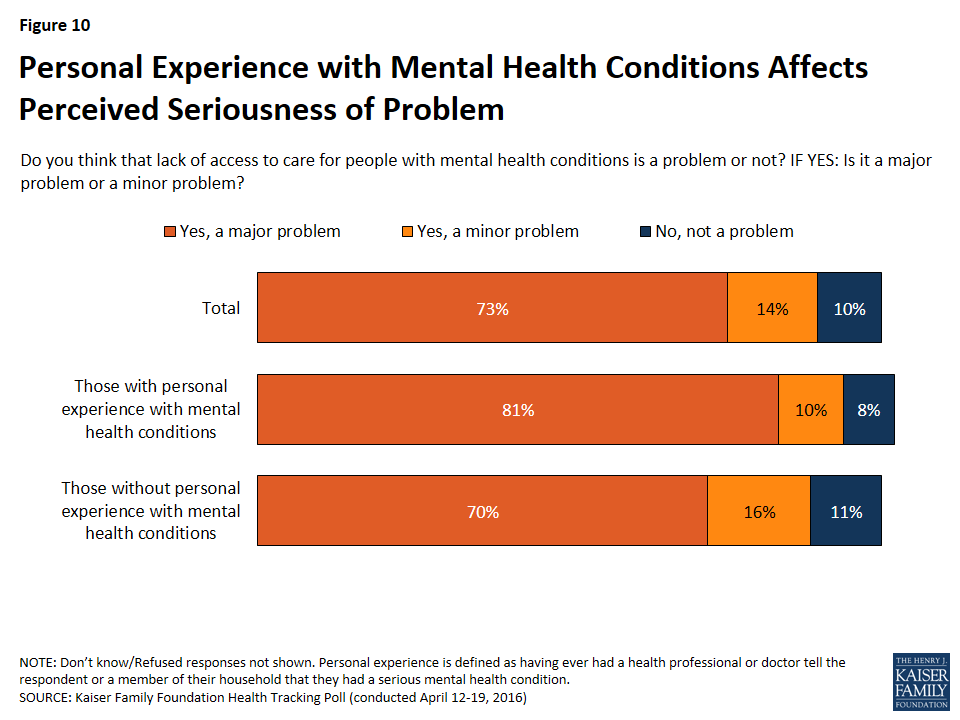
Discrimination and Mental Health Conditions
Substantial shares of the public think that people suffering from mental health conditions experience at least some prejudice and discrimination in this country today. About four in ten (42 percent) say those who suffer from depression face a lot of discrimination, and fewer (32 percent) say the same about those who suffer from anxiety.
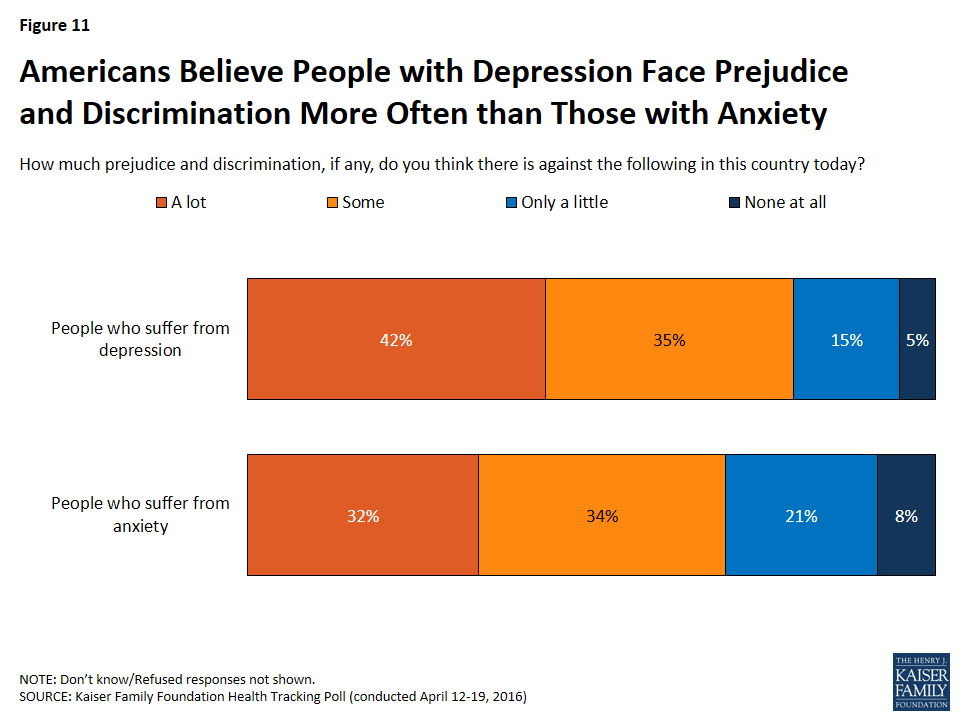
Substance Abuse and Mental Health Parity Laws
Policy makers have enacted legal protections aimed at addressing access to care for individuals with substance abuse problems and serious mental health conditions. The Mental Health Parity and Addiction Equity Act, ushered in as one of the many provisions of the Affordable Care Act, legally requires insurance plans to have the same rules for mental health benefits and substance abuse treatment as other medical services.3 However, many Americans remain unaware of these requirements. About four in ten (43 percent) know that health plans must have the same rules for mental health coverage, while an identical share thinks insurance companies can have separate rules and 13 percent don’t know. Fewer (30 percent) are aware that the requirement applies to substance abuse treatment, while over half (53 percent) incorrectly say insurance plans can have separate rules for substance abuse benefits and 15 percent don’t know. Individuals with personal connections to substance abuse and mental health conditions are no more likely than those without personal connections to know about the legal protections around such treatments.
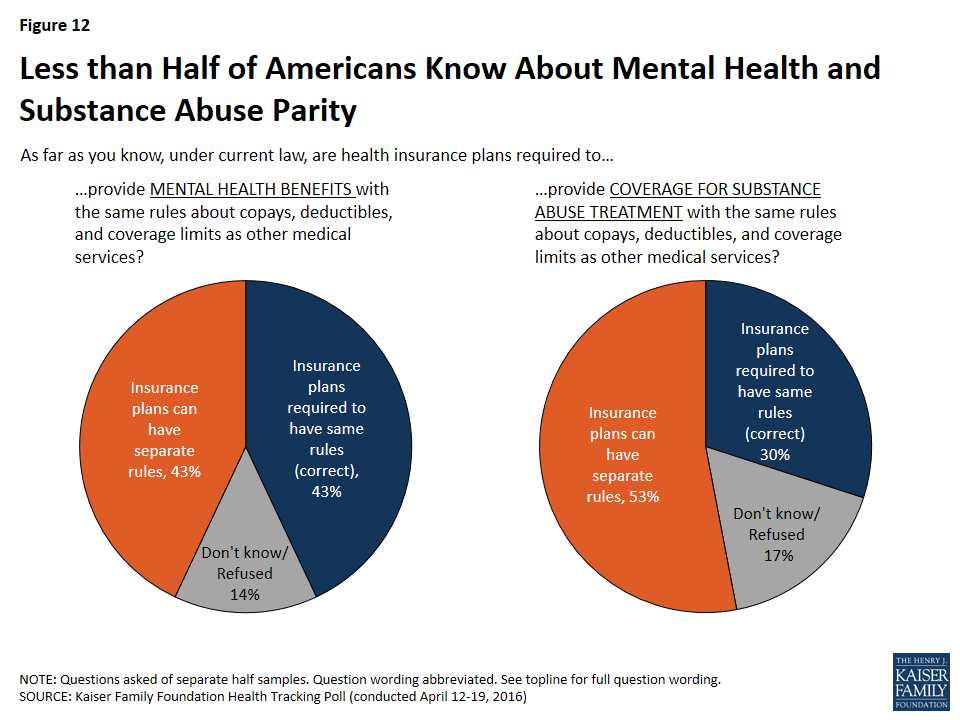
Methodology
This Kaiser Health Tracking Poll was designed and analyzed by public opinion researchers at the Kaiser Family Foundation (KFF). The survey was conducted April 12-19, 2016, among a nationally representative random digit dial telephone sample of 1,201 adults ages 18 and older, living in the United States, including Alaska and Hawaii (note: persons without a telephone could not be included in the random selection process). Computer-assisted telephone interviews conducted by landline (420) and cell phone (781, including 457 who had no landline telephone) were carried out in English and Spanish by Princeton Data Source under the direction of Princeton Survey Research Associates International (PSRAI). Both the random digit dial landline and cell phone samples were provided by Survey Sampling International, LLC. For the landline sample, respondents were selected by asking for the youngest adult male or female currently at home based on a random rotation. If no one of that gender was available, interviewers asked to speak with the youngest adult of the opposite gender. For the cell phone sample, interviews were conducted with the adult who answered the phone. KFF paid for all costs associated with the survey.
The combined landline and cell phone sample was weighted to balance the sample demographics to match estimates for the national population using data from the Census Bureau’s 2014 American Community Survey (ACS) on sex, age, education, race, Hispanic origin, and region along with data from the 2010 Census on population density. The sample was also weighted to match current patterns of telephone use using data from the January-June 2015 National Health Interview Survey. The weight takes into account the fact that respondents with both a landline and cell phone have a higher probability of selection in the combined sample and also adjusts for the household size for the landline sample. All statistical tests of significance account for the effect of weighting.
The margin of sampling error including the design effect for the full sample is plus or minus 3 percentage points. Numbers of respondents and margins of sampling error for key subgroups are shown in the table below. For results based on other subgroups, the margin of sampling error may be higher. Sample sizes and margins of sampling error for other subgroups are available by request. Note that sampling error is only one of many potential sources of error in this or any other public opinion poll. Kaiser Family Foundation public opinion and survey research is a charter member of the Transparency Initiative of the American Association for Public Opinion Research.
| Group | N (unweighted) | M.O.S.E. |
| Total | 1201 | ±3 percentage points |
| Party Identification | ||
| Democrats | 379 | ±6 percentage points |
| Republicans | 325 | ±6 percentage points |
| Independents | 342 | ±6 percentage points |
| Registered Voters | ||
| Total RV | 1006 | ±4 percentage points |
| Democrat RV | 331 | ±6 percentage points |
| Republican RV | 295 | ±7 percentage points |
| Independent RV | 279 | ±7 percentage points |
Endnotes
- http://www.nytimes.com/2016/04/21/us/first-criminal-charges-are-filed-in-flint-water-crisis.html ↩︎
- http://www.nytimes.com/2016/03/30/us/politics/obama-steps-upus-effort-to-fightabuse-of-heroin-and-painkillers.html?_r=0 ↩︎
- https://www.cms.gov/CCIIO/Programs-and-Initiatives/Other-Insurance-Protections/mhpaea_factsheet.html ↩︎